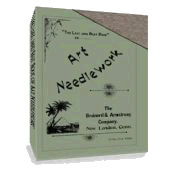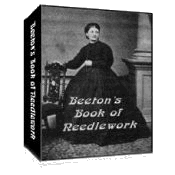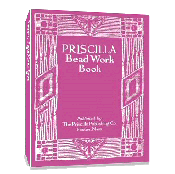[]Subscribe To This Site
Crazy Work Projects
The following items, in which crazy work is used, will all be found bright and attractive.
TABLE COVER
The body is of a rich claret colored sateen, and measures one and one-quarter yards each way. Felt may be substituted for sateen, but does not look as well. For the border, take four strips of Canton flannel, eight inches wide, and in length corresponding to the sides of the sateen center as a foundation for the crazy work.
On these strips baste pieces of silks, satins and velvets, of all styles and colors, following no regular arrangement. Next ornament the seams with fancy stitches in embroidery silks, (See illustration #1 below).

Click on picture to see more detail.
When complete, lay the strips along each of the four edges of the cover, joining neatly at the corners, and finishing top and bottom with bands of black or yellow satin ribbon, held in place by fancy stitches; then attach gay colored balls to the edges at intervals of four inches, using six or eight different colors which contrast prettily, and repeating the arrangement until the four sides are thus decorated.
It is an object in crazy work to use many bright colors, red in especial being most effective. Dull colored silks may be utilized by working them in judiciously with very bright pieces.
Scraps of black velvet scattered all through in proximity to the bright reds and paler tints add much to the general effect. It is a mystery where the idea of “crazy” patchwork originated. It was not considered an unreasonable supposition by those living in the mid 1800’s to believe that crazy work opened its eyes of origin among the unfortunates in some asylums, for, although partially demented, the majority were neither idle nor lacking in sensible adaptation to various works of skill.
LAMBREQUIN
CUSHION #1
CUSHION #2
Tack the bands to the cushion by invisible stitches and your work is complete.
For more Crazy Work information, see Cretonne Embroidery Applique.
Return to top of Crazy Work page.
Return to Types of Embroidery page.
Return to Home page.



 433 pages!
433 pages!

